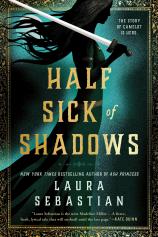Half Sick of Shadows
Review
Half Sick of Shadows
YA standout Laura Sebastian makes her adult fantasy debut with HALF SICK OF SHADOWS, which isn’t just another Arthurian retelling. Sure, readers will recognize many familiar faces, from Arthur and Morgan (Morgana in this version) to Guinevere, Merlin and Lancelot. But this adventure focuses on Elaine, famously eulogized in Alfred Tennyson’s “The Lady of Shalott.”
Sebastian puts Elaine’s ties to her friends center stage. She succeeds beautifully when she’s emphasizing the inextricably intertwined emotional bonds between these undeniably engaging characters. However, the story falls short because of its confusing narrative timelines in Elaine’s point of view. Its cast also feels rather immature at times, reading more like “Gossip Girl” meets “Merlin” plunked down into a sketchily drawn Camelot.
"Sebastian puts Elaine’s ties to her friends center stage. She succeeds beautifully when she’s emphasizing the inextricably intertwined emotional bonds between these undeniably engaging characters."
We begin by meeting Elaine, an oracular resident of the mystical island of Avalon, along with her childhood friends: the headstrong and powerful witch Morgana, the reckless princess Guinevere, the half-Fay (though the book constantly interchanges “Fey” and “Fay,” to this reader’s great confusion) Lancelot, and the fully human Arthur, who seems rather uninspired by comparison to his pals. As the book opens, the friends have to return to Camelot, where Arthur must assume his throne. Elaine and her friends bear the responsibility of protecting the Once and Future King at all costs, even to the detriments of their hearts and once-strong friendships.
As an oracle, Elaine is plagued by visions of the many possible futures ahead of her and her friends. Most, like the traditional Arthurian stories of Lance and Gwen’s adultery and Morgan’s attempts to kill Arthur, are filled with heartbreak and betrayal. Determined to evade these tragedies at all costs, Elaine tells her story in three timelines: the past, in which the friends bond on Avalon; the present, returning to Camelot and attempting to win over the kingdom to Arthur; and the (possible) futures ahead of them all.
In working to avoid retelling the all-too-familiar stories of lust and murder as part of the novel's central narrative, Sebastian relegates them to what-if visions. These end up being far more engaging than what’s going on in the present day at Camelot. Moreover, the tantalizing glimpses we get of the friends’ childhood on Avalon are equally compelling and worthy of their own book, rather than getting short shrift.
Elaine’s desire to protect Arthur, billed by Nimue, Lady of the Lake, as the savior of humankind and Fay, is at war with her desire to protect herself and her friends. But because the deep emotions are scattered with perplexing plots and various real events and other possible ones, we lose out on their true potential impact. Instead, Elaine seems more like the Dan Humphrey of the group, attempting to penetrate and manipulate some teenage pals, than a grown woman who holds an important position at Camelot.
I would have loved to have seen the adventures on Avalon in linear time, peppered with some (not all, since they are overwhelming) visions, and then the characters’ gradual evolution. Instead, the intersecting timelines create a truncated story that ultimately may leave some readers unsatisfied.
Reviewed by Carly Silver on July 9, 2021




